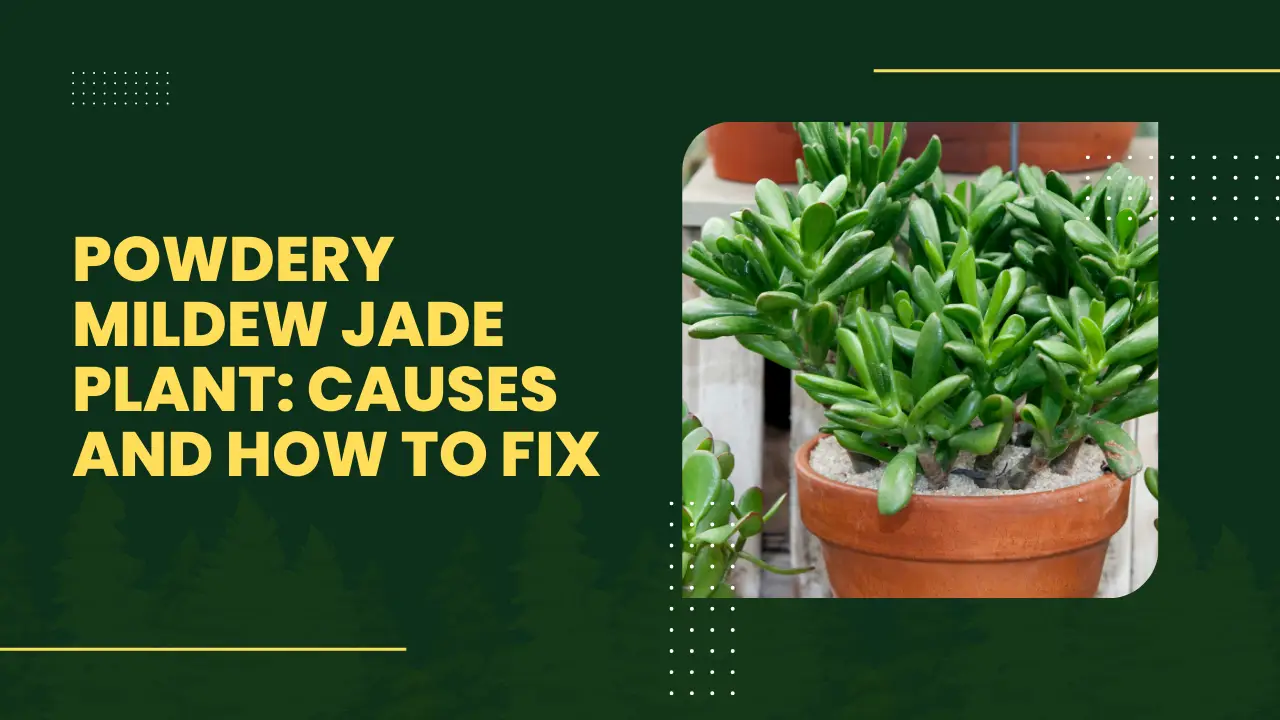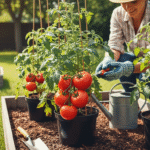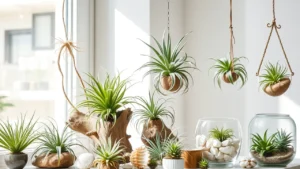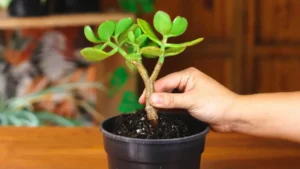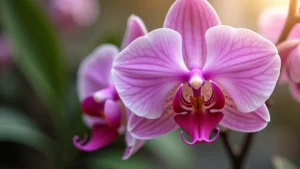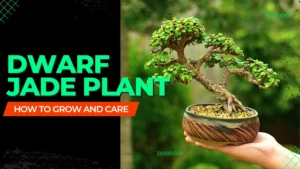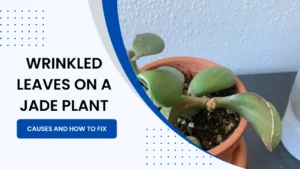If your jade plants have white powdery coatings on the leaves, you likely have powdery mildew. Also, powdery mildew spreads spores throughout your jade plant.
Even worse, powdery mildew can cause your jade plant to develop corky brown lesions. It is a fungal disease that can take over your jade plant.
Due to its rapid spread, powdery mildew can be difficult to treat. However, you can remove powdery mildew from your jade plant using some simple steps!
Here, we will discuss how to identify powdery mildew. In addition, the treatment options that could work for your jade plants.
Using this guide, you can successfully remove powdery mildew from your jade plant without too much trouble!
That being said, let’s begin
Table of Contents
What Causes Powdery Mildew in a Jade Plant?
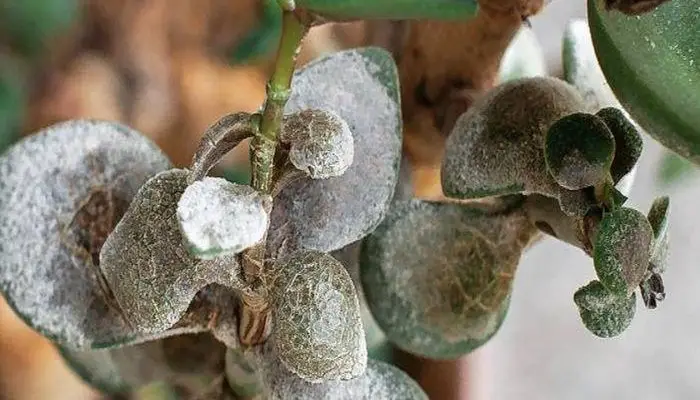
In wet weather, powdery mildew is more likely to occur.
As they spread rapidly in humid conditions, they tend to affect plants with poor air circulation more than others.
Besides being affected by humidity, powdery mildew also needs high levels of nitrogen in the soil to grow. So, if you have been fertilizing your jade plant too much, powdery mildew may develop.
Moreover, powdery mildew can be spread from plant to plant. So, if you grow plants in the same family as your succulents, they can spread powdery mildew.
Also, in temperate regions, powdery mildew is the most prevalent plant disease. Hence, make sure you don’t get powdery mildew on your jade. As it’s a highly contagious fungus that can cover your plants fast.
Symptoms of Powdery Mildew
On a jade plant, powdery mildew looks like white powder. It is not always the case with succulents, since their leaves tend to be thick and waxy.
However, there are several ways powdery mildew can appear on your jade plant.
- Leaves and stems covered in a powdery white coating
- Soil covered in powdery white powder
- In some cases, powdery mildew appears as a yellow or red crust or film on leaves or stems.
The white powder or patch that forms over leaves and stems looks like dust. However, it will rub off, unlike natural dirt, which stays in place for years.
The disease usually begins at the bottom of the plant, where it is wettest after watering. And then spreads upwards until it covers the entire plant.
Some brownish spots may also appear on the leaf surface underneath these powder patches. While yellowing spots can also appear in older growth, but not always.
Thankfully, powdery mildew does not affect a plant’s roots.
How to fix Powdery Mildew on a Jade Plant?
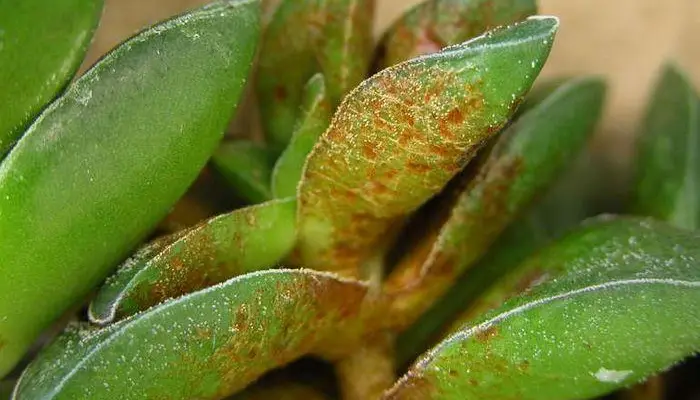
A variety of effective treatment methods are available depending on the severity of powdery mildew on your jade plant. Here are some effective powdery mildew remedies for jade plants.
Neem Oil
You can use Neem Oil on the Jade plant to kill powdery mildew.
Pour a tablespoon of neem oil into a gallon of water. Apply it every two weeks until the powdery mildew on your plant disappears.
Dish Soap and Water
Water and dish soap work well together.
In a spray bottle, combine a few drops of dish soap with warm water.
Shake the mixture well to ensure it is mixed well. Then spray on your jade leaves with an eyedropper. If you have a spray nozzle attachment, you can use it.
Using this powdery mildew treatment method will kill powdery mildew fast. However, make sure not to get any dish soap solution into the soil.
Baking Soda
An effective mildew treatment is baking soda powder.
Add one tablespoon of baking soda to a gallon of water. Spray that mixture onto jade’s leaves. Apply it every two weeks until the mildews have disappeared.
Hydrogen Peroxide
In a half-gallon of water, mix 1 teaspoon hydrogen peroxide powder. After that, spray the solution.
Use it every two weeks on the leaves of your jade plant until powdery mildews have disappeared.
For each application, hydrogen peroxide solutions should be mixed up fresh. Because they lose their potency after several days once mixed with water.
Insecticidal Soap or Horticultural Oil Spray
To use insecticidal soap or horticultural oil sprays, mix 1 tablespoon powder into 1 gallon of water.
Use either an eye dropper for small plants or a spray nozzle attachment if you have one to apply the solution.
Like dish soap and water, it can kill powdery mildew quickly. Nevertheless, avoid getting powder mixtures in the soil.
Remove Powdery Mildew Infected Leaves
When you see powder-covered leaves on plant leaves, get rid of them as soon as possible.
By catching the infection early, it can prevent the infection from spreading to other succulent plants.
Mouthwash
Using mouthwash helps reduce powdery mildew.
Every two weeks, spray your jade leaves with mouthwash mixed with water until powdery mildews are gone.
The mouthwash powder mixture works just as well as other powder treatments. In addition, it makes them taste like mint, which keeps deer, rabbits, raccoons, and squirrels away!
Clean Up
Reduce humidity and fungal spores in the area by collecting and removing fallen diseased leaves.
The spores of powdery mildew propagate easily through water and even in the air. Hence, you should remove fallen leaves infected with the disease.
Reduced Humidity
In humid environments, mildew thrives, so reduce humidity to prevent it. Also, it is important not to overwater in order to reduce humidity.
According to Cornell University plant experts, jade needs to be watered once a week right after its soil dries out thoroughly.
Overly moist soil can cause roots to rot, and powdery mildew on jade leaves is caused by the humidity produced by overly damp soil.
Proper Watering
According to Iowa State University Extension, water your plants early in the morning so their leaves can dry off during warmer days.
Try to pour water directly on the soil at the base of the plant rather than over the foliage. Powdery mildew doesn’t like this method because it keeps jade plant leaves dry.
Temperature
As Iowa State University Extension suggests, keep plants away from cold drafts. It is best to keep the plant away from drafts to prevent powdery mildew from growing.
Milk
Lastly, milk is showing promise as a way to control powdery mildew. Scientists are still trying to figure out how the compounds in milk might act as antiseptics and fungicides as well as increase a plant’s immunity.
It tends to prevent powdery mildew on zucchini, squash, and cucumbers. So, it’s worth a try on the jade plants. One part milk to two parts water is an effective mixture ratio.
How to Control the Spread of Powdery Mildew
It is important to remove your jade plant as soon as possible when it becomes infected with powdery mildew.
Alternatively, try isolating it from them so they can’t come into contact with each other.
If you are working around one plant only, be sure to sterilize any tools or containers used to work around it. This prevents mold spores from spreading to other plants.
Although the infection won’t spread to the rest of your collection on its own, you should watch out for other symptoms.
Later, if any more plants show signs of powdery mildew, quarantine them immediately!
Any leaves infected with powdery mildew can also be pruned off and discarded immediately to control its spread. Make sure you discard infected leaves in a closed garbage bag so spores don’t escape and infect other plants. Also, sterilize any tools you use after working with those infected leaves!
In addition, you should keep an eye out for powdery mildew on your succulents. The sooner something suspicious is detected, the more likely it is to be treated completely before spreading.
How To Prevent Powdery Mildew on Jade Plant
The powdery mildew on succulents is caused by fungi and looks like white spots. Since this fungus thrives in moist environments, you should ensure your plants don’t stay wet for too long and dry out between waterings.
Usually, powdery mildew occurs on plants that experienced a moisture imbalance during their lifetime.
Although powdery mildews do not cause death, they stunt growth and cause flowers and leaves to turn yellow and drop prematurely.
To prevent powdery mildew infections, make sure your plants have access to sunlight, air, and water. It’s best not to direct expose succulents to the hot afternoon sun since they prefer bright sunlight. Give them at least six hours of fresh air each day, and don’t let water sit in saucers or collect on their leaves.
Ensure that all dead leaves and stems have been cleaned up, as they can serve as breeding grounds for powdery mildew.
If you notice white mold on your jade plant, don’t panic and water or fertilize it too much in an attempt to fix it.
In addition, it is crucial to avoid overhead watering whenever possible. Because standing water poses a greater risk of fungal infections, including powdery mildews than bacterial infections, which require direct contact with plants.
Additionally, it is common for jade plants to suffer from powdery mildew. Yet to prevent further spreading of the infection, it is imperative to keep the humidity levels low once they have been infected.
Conclusion
When caught early, powdery mildew on a jade plant is very easy to treat.
Whenever you grow jade indoors or in an enclosed area, check for powdery mildew before moving it outside.
Also, it is always best to prevent powdery mildew from occurring, so look for healthy-looking leaves with yellow or brown spots.
If not treated quickly, it can spread rapidly across multiple succulent varieties in just a few days. However, you can use the above-mentioned methods to fix your jade plant.
Listed below are the most frequently asked questions by succulent lovers. Look through them to see if they answer any of your questions.
FAQs
Q1. Will powdery mildew go away on its own?
There is a possibility that a mild case will go away by itself. For them to survive, the plant must provide them with nutrients. Unlike most types of fungi, they cause more severe disease in warm, dry weather.
Q2. Is dish soap effective in killing powdery mildew?
Yes, also it is easiest to treat powdery mildew by mixing 1 tablespoon baking soda with 1/2 teaspoon liquid dish soap in 1 gallon of water. It is common in low humidity and mild climate areas to find these types of mildew.
Q3. How does vinegar kill powdery mildew?
Like mouthwash, vinegar contains acetic acid, which can control powdery mildew. To get the best results, mix 2-3 tablespoons of apple cider vinegar containing 5% acetic acid with a gallon of water.
Q4. Which fungicide is the best for powdery mildew?
Here are the best fungicides for getting rid of powdery mildew, snow mold, grass, and lawn fungi
1. Bonide 811 Copper 4E Fungicide.
2. Spectracide 51000-1 Immunox Fungicide.
3. Serenade Garden AGRSER32 Organic Fungicide.
4. Scotts DiseaseEx Lawn Fungicide.
Q5. What is the best treatment for powdery mildew?
Baking soda- Spray one gallon of water with one tablespoon baking soda mixed with one half teaspoon liquid, non-detergent soap. You can also kill powdery mildew spores with the mouthwash that you use every day to kill germs in your mouth.
Q6. Should I remove leaves with powdery mildew?
Yes, discard any affected leaves and any that have fallen to the ground. Moreover, treat the rest of the plant preventatively. Likewise, if you see powdery mildew on buds, remove them and discard them.
Q7. What is a natural remedy for powdery mildew?
Combine 1 tablespoon baking soda with 1 tablespoon vegetable oil and 1 teaspoon dish soap in 1 gallon of water. To make this solution, mix 4 tablespoons baking soda with 2 tablespoons Murphy’s oil soap. Add 2 to 3 tablespoons of vinegar to 1 gallon of water. Testing this first is important because vinegar can burn plants.
Q8. Why Do Succulents Get Powdery Mildew?
In terms of maintenance, succulents are very low-maintenance plants. If left untreated, powdery mildew can wipe out an entire collection in days.
There are a few reasons why succulents are vulnerable to powdery mildew.
1. It prefers warm, damp conditions, so powdery mildew tends to attack succulents in summer. Also, it attacks if it is hot and humid or if you are indoors in poor circulation.
2. In addition, powdery mildew grows by germinating spores that float through the air from plant to plant.
Beware, without proper precautions, any succulents you bring into your home could potentially infect your entire collection!
Q9. In what ways can powdery mildew cause damage?
Succulents usually don’t die from powdery mildew, but they can cause severe damage to them.
Basically, the powder is composed of fungi that spread quickly and block out light from leaves. As a result, leaves turn yellow and die.
Moreover, powdery mildew isn’t just harmful to plants’ looks; it will also hamper their growth and prevent them from blooming!
It is also possible for powdery mildew to spread to other plants in your garden due to the release of fungus spores.
In addition to powdery mildew, mealybugs, spider mites, and aphids may also be attracted to jade plants with powdery mildew.
Q10. How do you kill powdery mildew spores?
Potassium bicarbonate also kills powdery mildew, just like baking soda. As a contact fungicide, potassium bicarbonate kills powdery mildew spores quickly.

